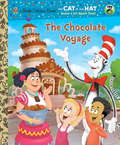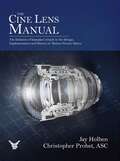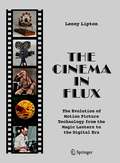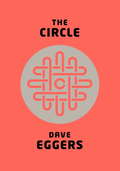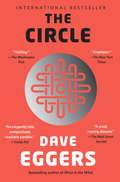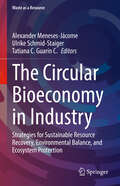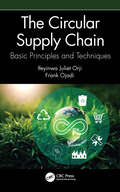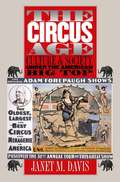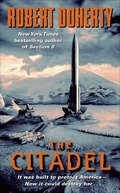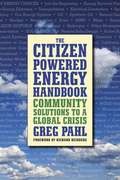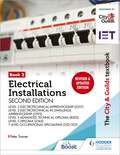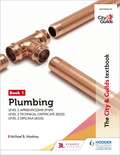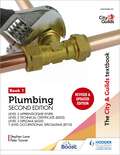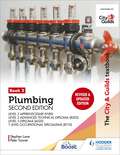- Table View
- List View
The Chocolate Voyage (Little Golden Book)
by Dave Aikins Tish RabeWhen the Cat in the Hat eats Nick's last piece of chocolate, the gang visits the Forest of Coco-a-licious to learn to make their own. There they discover that chocolate is made from cocoa beans which grow on trees--and that the raw beans actually taste pretty awful! Undeterred, the gang help harvest, dry, and roast the beans, separate the cocoa butter and liquids, and cook the mixture with sugar to make the sweet confection we all know and love. A perfectly tasty read for any time of the year, The Chocolate Voyage is ideal for Christmas, Valentine's Day, Easter, Halloween--any time chocolate is on the menu! Fans of the hit PBS Kids' television show The Cat in the Hat Know a Lot About That! will gobble this one up!
The Cine Lens Manual
by Jay Holben Christopher Probst AscFor anyone with a curiosity about cinema optics, The Cine Lens Manual is the definitive filmmaker's guide to the design, implementation, and history of motion picture optics. Authors Jay Holben and Christopher Probst share more than 60 years experience as cinematographers, educators, and technical journalists, creating a manual for anyone who seeks a deeper understanding of the cinema lens. This hardcover offers a comprehensive examination of the cine lens, with a deep dive into the art and science behind creating a cinema lens. <P><P> Cinematographers, directors, VFX artists, camera assistants, animators, historians, students, and rental house technicians will all benefit from the clear, easy to understand concepts, explained in simple language. Extensively illustrated, this manual examines the history and evolution of the cinema lens and motion picture formats.
The Cinema in Flux: The Evolution of Motion Picture Technology from the Magic Lantern to the Digital Era
by Lenny LiptonThe first of its kind, this book traces the evolution of motion picture technology in its entirety. Beginning with Huygens' magic lantern and ending in the current electronic era, it explains cinema’s scientific foundations and the development of parallel enabling technologies alongside the lives of the innovators. Product development issues, business and marketplace factors, the interaction of aesthetic and technological demands, and the patent system all play key roles in the tale. The topics are covered sequentially, with detailed discussion of the transition from the magic lantern to Edison’s invention of the 35mm camera, the development of the celluloid cinema, and the transition from celluloid to digital. Unique and essential reading from a lifetime innovator in the field of cinema technology, this engaging and well-illustrated book will appeal to anyone interested in the history and science of cinema, from movie buffs to academics and members of the motion picture industry.
The Circle
by Dave EggersThe Circle is the exhilarating new novel from Dave Eggers, bestselling author of A Hologram for the King, a finalist for the National Book Award. When Mae Holland is hired to work for the Circle, the world's most powerful internet company, she feels she's been given the opportunity of a lifetime. The Circle, run out of a sprawling California campus, links users' personal emails, social media, banking, and purchasing with their universal operating system, resulting in one online identity and a new age of civility and transparency. As Mae tours the open-plan office spaces, the towering glass dining facilities, the cozy dorms for those who spend nights at work, she is thrilled with the company's modernity and activity. There are parties that last through the night, there are famous musicians playing on the lawn, there are athletic activities and clubs and brunches, and even an aquarium of rare fish retrieved from the Marianas Trench by the CEO. Mae can't believe her luck, her great fortune to work for the most influential company in the world--even as life beyond the campus grows distant, even as a strange encounter with a colleague leaves her shaken, even as her role at the Circle becomes increasingly public. What begins as the captivating story of one woman's ambition and idealism soon becomes a heart-racing novel of suspense, raising questions about memory, history, privacy, democracy, and the limits of human knowledge.From the Hardcover edition.
The Circle
by Dave EggersThe Circle is the exhilarating new novel from Dave Eggers, bestselling author of A Hologram for the King, a finalist for the National Book Award. <P>When Mae Holland is hired to work for the Circle, the world's most powerful internet company, she feels she's been given the opportunity of a lifetime. <P>The Circle, run out of a sprawling California campus, links users' personal emails, social media, banking, and purchasing with their universal operating system, resulting in one online identity and a new age of civility and transparency. <P>As Mae tours the open-plan office spaces, the towering glass dining facilities, the cozy dorms for those who spend nights at work, she is thrilled with the company's modernity and activity. <P>There are parties that last through the night, there are famous musicians playing on the lawn, there are athletic activities and clubs and brunches, and even an aquarium of rare fish retrieved from the Marianas Trench by the CEO. <P>Mae can't believe her luck, her great fortune to work for the most influential company in the world--even as life beyond the campus grows distant, even as a strange encounter with a colleague leaves her shaken, even as her role at the Circle becomes increasingly public. <P>What begins as the captivating story of one woman's ambition and idealism soon becomes a heart-racing novel of suspense, raising questions about memory, history, privacy, democracy, and the limits of human knowledge.
The Circle (A Dan Lenson Novel #3)
by David PoyerA novel of duty, betrayal, and adventure in the world's most dangerous seas (the Arctic), by the bestselling author of The Med and The Gulf.
The Circular Bioeconomy in Industry: Strategies for Sustainable Resource Recovery, Environmental Balance, and Ecosystem Protection (Waste as a Resource)
by Alexander Meneses-Jácome Ulrike Schmid-Staiger Tatiana C. Guarín C.This book serves as a starting point for readers to understand the concepts of the circular economy and bioeconomy and how they can be applied to industrial processes. The notion of having eco-friendly industries is a recent development, with a growing interest in the environmental impact of industrial practices, particularly with regard to resource recovery practices for valuable nutrients and byproducts, which aligns with the circular economy and bioeconomy concepts that aim to establish a "continuous flow of materials." Currently, the focus is on studying the environmental impact and developing strategies to achieve a balance with water ecosystems for sustainable and equitable coexistence. The success of these concepts will depend on a robust framework that evaluates the environmental trade-offs and co-benefits of improving industry practices to enhance ecosystem protection. This book introduces circular economy practices in industry, along with tips, procedures, recommendations, and lessons learned.
The Circular Supply Chain: Basic Principles and Techniques
by Ifeyinwa Juliet Orji Frank OjadiOrganizations need to stay competitive and transition from a linear make-use-dispose supply chain model to a sustainable one. This book covers techniques and basic principles, historical developments and recent issues facing the adoption of a circular supply chain model. The Circular Supply Chain: Basic Principles and Techniques presents the key principles and techniques for the effective integration of a circular economy into supply chains. It discusses sustainability, digitization and the application of blockchain to enhance operations within the realm of Industry 4.0. Principles to assist managers in effectively adopting circularity business models for sustainability improvements are provided, along with the historical background, so the reader can have a better understanding for implementation. Case studies and reading comprehension questions are also offered to help with the effective integration of a circular economy into supply chains. This book is written to assist students, practicing engineers and business professionals that work in the industrial and manufacturing sectors, supply chain management, and with advanced technologies associated with Industry 4.0, sustainability, blockchain and digitalization integration techniques of circular supply chains.
The Circus Age
by Janet M. DavisA century ago, daily life ground to a halt when the circus rolled into town. Across America, banks closed, schools canceled classes, farmers left their fields, and factories shut down so that everyone could go to the show. In this entertaining and provocative book, Janet Davis links the flowering of the early-twentieth-century American railroad circus to such broader historical developments as the rise of big business, the breakdown of separate spheres for men and women, and the genesis of the United States' overseas empire. In the process, she casts the circus as a powerful force in consolidating the nation's identity as a modern industrial society and world power.Davis explores the multiple "shows" that took place under the big top, from scripted performances to exhibitions of laborers assembling and tearing down tents to impromptu spectacles of audiences brawling, acrobats falling, and animals rampaging. Turning Victorian notions of gender, race, and nationhood topsy-turvy, the circus brought its vision of a rapidly changing world to spectators--rural as well as urban--across the nation. Even today, Davis contends, the influence of the circus continues to resonate in popular representations of gender, race, and the wider world.
The Citadel
by Robert DohertyIt was built to protect America. Now it could destroy the world. A pulse-pounding technothriller from the New York Times–bestselling author of Section 8.At the start of the Cold War, the greatest threat to America wasn’t the Russians and the looming Communist threat. Rather, it was an elite organization bent on world domination, a group so powerful only nuclear weapons could safeguard against them. The CIA knew what these men were capable of, and in a last-ditch attempt to protect America against them, they built two high–security arsenals deep within the earth––one declassified in the Nevada desert, and one heavily under wraps in Antarctica. For over fifty years, no one spoke of The Citadel, the fortress deep under the ice in Antarctica that held the most powerful weapon known to man––until the Organization returned, hellbent on destruction.Captain Jim Vaughn is a government agent known for performing missions no one else wants. So when an old colleague approaches him with an assignment, he can’t refuse––even if the mission has been set in motion by a dead man’s letter, found in Antarctica and dated 1949. The Citadel has been cracked, and the only man who can safeguard it is Vaughn. Nothing short of the fate of mankind rests on his shoulders.
The Citizen-Powered Energy Handbook: Community Solutions to a Global Crisis
by Greg PahlA synopsis of various options available for local, renewable, community-owned energy.
The Citrus Genome (Compendium of Plant Genomes)
by Alessandra Gentile Stefano La Malfa Ziniu DengThis book reviews how the release of the citrus genome facilitates the investigation of ancestral species, the study of their complex biological features, and the genetic basis of agronomic traits of paramount importance for their sustainable cultivation. The first chapters discuss citrus origin and distribution, and the economic importance and varietal composition of the cultivated species, providing an overview of citrus and related genera genetic resources. The book then describes the role of traditional breeding techniques (for scion and rootstocks) as well as the potential of genomic breeding and innovative protocols for biotechnological approaches. The second part provides essential information on the genus Citrus, the attributes of pure citrus species, genetic admixtures, hybrids and citrus relatives, and on the horticultural classification of cultivated species, varieties and rootstocks. The third part then focuses on the different molecular mechanisms, covering various aspects of citrus biology, including the role of beneficial compounds of citrus fruits. In addition, it examines the molecular responses of citrus to abiotic stresses and to field and post-harvest diseases. Providing insights gained in recent years, it is a valuable guide for those who are interested in gene discovery, comparative genomics, molecular breeding and new breeding techniques. It is particularly useful for scientists, breeders and students at universities and public sector institutes involved in research for the citrus industry.
The City & Guilds Textbook (5357 and 5393), Level 2 Technical Certificate (8202), Level 2 Diploma (2365) & T Level Occupational Specialisms (8710): For The Level 3 Apprenticeship (5357), Level 2 Technical Certificate (8202), Level 2 Diploma (2365) And T Level Occupational Specialisms (352/353)
by Peter TannerEquip yourself with the tools for success in Electrical Installations with this comprehensive and updated edition of our bestselling textbook, published in association with City & Guilds and IET. - Study with confidence using the most up-to-date information available for the new industry standards, including the 2022 amendments to BS7671: 2018, The IET Wiring Regulations 18th edition - Enhance your understanding of concepts in electrical installation with 100s of clear and accurate technical drawings and step-by-step photo sequences- Get ready for the workplace with industry tips- Prepare for your trade tests or end-of-year exams with end-of-chapter practice questions - Engage with author Peter Tanner's accessible text, drawing on his extensive industry experience- Target your learning with detailed qualification mapping grids for the latest City & Guilds Level 2 qualifications - including the 2365, 8202, 5357 and 5393 specifications, as well as the 352 and 353 T Level occupational specialisms
The City & Guilds Textbook (5357 and 5393), Level 2 Technical Certificate (8202), Level 2 Diploma (2365) & T Level Occupational Specialisms (8710): For The Level 3 Apprenticeship (5357), Level 2 Technical Certificate (8202), Level 2 Diploma (2365) And T Level Occupational Specialisms (352/353)
by Peter TannerEquip yourself with the tools for success in Electrical Installations with this comprehensive and updated edition of our bestselling textbook, published in association with City & Guilds and IET. - Study with confidence using the most up-to-date information available for the new industry standards, including the 2022 amendments to BS7671: 2018, The IET Wiring Regulations 18th edition - Enhance your understanding of concepts in electrical installation with 100s of clear and accurate technical drawings and step-by-step photo sequences- Get ready for the workplace with industry tips- Prepare for your trade tests or end-of-year exams with end-of-chapter practice questions - Engage with author Peter Tanner's accessible text, drawing on his extensive industry experience- Target your learning with detailed qualification mapping grids for the latest City & Guilds Level 2 qualifications - including the 2365, 8202, 5357 and 5393 specifications, as well as the 352 and 353 T Level occupational specialisms
The City & Guilds Textbook (5357 and 5393), Level 3 Advanced Technical Diploma (8202), Level 3 Diploma (2365) & T Level Occupational Specialisms (8710): For The Level 3 Apprenticeship (5357), Level 3 Advanced Technical Diploma (8202), Level 3 Diploma (2365) And T Level Occupational Specialisms (352/353)
by Peter TannerEquip yourself with the tools for success in Electrical Installations with this comprehensive and updated edition of our bestselling textbook, published in association with City & Guilds and IET. - Study with confidence using the most up-to-date information available for the new industry standards, including the 2022 amendments to BS7671: 2018, The IET Wiring Regulations 18th edition - Enhance your understanding of concepts in electrical installation with 100s of clear and accurate technical drawings and step-by-step photo sequences- Practise maths and English in context, with embedded 'Improve your maths' and 'Improve your English' activities- Get ready for the workplace with industry tips- Prepare for your trade tests or end-of-year exams with end-of-chapter practice questions - Engage with author Peter Tanner's accessible text, drawing on his extensive industry experience- Target your learning with detailed qualification mapping grids for the latest City & Guilds Level 3 qualifications - including the 2365, 8202, 5357 and 5393 specifications, as well as the 352 and 353 T Level occupational specialisms
The City & Guilds Textbook (5357 and 5393), Level 3 Advanced Technical Diploma (8202), Level 3 Diploma (2365) & T Level Occupational Specialisms (8710): For The Level 3 Apprenticeship (5357), Level 3 Advanced Technical Diploma (8202), Level 3 Diploma (2365) And T Level Occupational Specialisms (352/353)
by Peter TannerEquip yourself with the tools for success in Electrical Installations with this comprehensive and updated edition of our bestselling textbook, published in association with City & Guilds and IET. - Study with confidence using the most up-to-date information available for the new industry standards, including the 2022 amendments to BS7671: 2018, The IET Wiring Regulations 18th edition - Enhance your understanding of concepts in electrical installation with 100s of clear and accurate technical drawings and step-by-step photo sequences- Practise maths and English in context, with embedded 'Improve your maths' and 'Improve your English' activities- Get ready for the workplace with industry tips- Prepare for your trade tests or end-of-year exams with end-of-chapter practice questions - Engage with author Peter Tanner's accessible text, drawing on his extensive industry experience- Target your learning with detailed qualification mapping grids for the latest City & Guilds Level 3 qualifications - including the 2365, 8202, 5357 and 5393 specifications, as well as the 352 and 353 T Level occupational specialisms
The City & Guilds Textbook (5357), Level 2 Technical Certificate (8202) & Level 2 Diploma (2365): For The Level 3 Apprenticeship (5357), Level 2 Technical Certificate (8202), Level 2 Diploma (2365) And T Level Occupational Specialisms (352/353)
by Peter TannerEquip yourself with the tools for success in Electrical Installations, with this comprehensive new textbook published in association with City & Guilds and IET which has been fully-updated in line with the 2018, 18th Edition wiring regulations.-Study with confidence, using the most up-to-date information available for the new specifications and industry standards-Enhance your understanding of concepts in electrical installation with clear and accurate technical drawings and step-by-step photo sequences -Prepare for your trade tests or end of year exams, with end of chapter practice questions and a final assessment preparation chapter-Get ready for the workplace with Industry Tips and guidance on values and behaviours-Engage with author Peter Tanner's accessible text, drawing on his extensive industry experience
The City & Guilds Textbook (5357), Level 2 Technical Certificate (8202) & Level 2 Diploma: Electrical Install Bk 1 Epub
by Peter TannerEquip yourself with the tools for success in Electrical Installations, with this comprehensive new textbook published in association with City & Guilds and IET which has been fully-updated in line with the 2018, 18th Edition wiring regulations.-Study with confidence, using the most up-to-date information available for the new specifications and industry standards-Enhance your understanding of concepts in electrical installation with clear and accurate technical drawings and step-by-step photo sequences -Prepare for your trade tests or end of year exams, with end of chapter practice questions and a final assessment preparation chapter-Get ready for the workplace with Industry Tips and guidance on values and behaviours-Engage with author Peter Tanner's accessible text, drawing on his extensive industry experience
The City & Guilds Textbook (5357), Level 3 Advanced Technical Diploma (8202) & Level 3 Diploma (2365): For The Level 3 Apprenticeship (5357), Level 3 Advanced Technical Diploma (8202), Level 3 Diploma (2365) And T Level Occupational Specialisms (352/353)
by Peter TannerComplete your pathway to a career in electrical installation with Electrical Installations Book 2, published in association with City & Guilds and IET. This fully revised new textbook has been fully-updated in line with the 2018, 18th Edition wiring regulations.-Study with confidence, using the most up-to-date information available for the new specifications and industry standards-Enhance your understanding of concepts in electrical installation with clear and accurate technical drawings, and step-by-step photo sequences -Prepare for your trade tests or end of year exams, with end of chapter practice questions and a final assessment preparation chapter-Get ready for the workplace with Industry Tips and guidance on values and behaviours-Engage with author Peter Tanner's accessible text, drawing on his extensive industry experience
The City & Guilds Textbook (9189), Level 2 Technical Certificate (8202) & Level 2 Diploma (6035): For The Level 3 Professional Plumbing Apprenticeship And Level 2 Technical Certificate In Plumbing
by Michael MaskreyEquip yourself with the tools for success with Plumbing Book 1, published in association with City & Guilds- Study with confidence, covering all core content for the 6035, 9189 and 8202 specifications. - Get to grips with technical content presented in accessible language.- Enhance your understanding of plumbing practice with clear and accurate illustrations and diagrams demonstrating the technical skills you need to master.- Practise maths and English in context, with embedded 'Improve your maths' and 'Improve your English' activities. - Test your knowledge with end of chapter practice questions and practical tasks.- Prepare for the workplace with up-to-date information on relevant key regulations and industry standards.- Keep your knowledge current, with clear coverage of major modern cold water, hot water, central heating, sanitation and rainwater systems.
The City & Guilds Textbook (9189), Level 2 Technical Certificate (8202) & Level 2 Diploma (6035): for the Level 3 Professional Plumbing Apprenticeship and Level 2 Technical Certificate in Plumbing
by Michael MaskreyEquip yourself with the tools for success with Plumbing Book 1, published in association with City & Guilds- Study with confidence, covering all core content for the 6035, 9189 and 8202 specifications. - Get to grips with technical content presented in accessible language.- Enhance your understanding of plumbing practice with clear and accurate illustrations and diagrams demonstrating the technical skills you need to master.- Practise maths and English in context, with embedded 'Improve your maths' and 'Improve your English' activities. - Test your knowledge with end of chapter practice questions and practical tasks.- Prepare for the workplace with up-to-date information on relevant key regulations and industry standards.- Keep your knowledge current, with clear coverage of major modern cold water, hot water, central heating, sanitation and rainwater systems.
The City & Guilds Textbook (9189), Level 2 Technical Certificate (8202), Level 2 Diploma (6035) & T Level Occupational Specialisms (8710): For The Level 3 Apprenticeship (9189), Level 2 Technical Certificate (8202), Level 2 Diploma (6035) And T Level Occupational Specialisms
by Peter Tanner Stephen LaneEquip learners with the tools for success in a career as a plumber with this comprehensive and updated edition of our bestselling textbook, published in association with City & Guilds.The new edition will help learners to: - Study with confidence, covering all core content for the 6035, 9189 and 8202 specifications, as well as the 355 and 356 plumbing and heating T Level occupational specialisms.- Target learning with detailed qualification mapping grids.- Get to grips with technical content presented in accessible language.- Enhance their understanding of plumbing practice with clear and accurate illustrations and diagrams demonstrating the technical skills you need to master.- Practise maths and English in context, with embedded 'Improve your maths' and 'Improve your English' activities.- Test their knowledge with end-of-chapter practice questions, synoptic assessments and practical tasks.- Prepare for the workplace with up-to-date information on relevant key regulations and industry standards.- Keep their knowledge current, with clear coverage of major modern cold water, hot water, central heating, sanitation, rainwater systems and environmental technologies.
The City & Guilds Textbook (9189), Level 2 Technical Certificate (8202), Level 2 Diploma (6035) & T Level Occupational Specialisms (8710): For The Level 3 Apprenticeship (9189), Level 2 Technical Certificate (8202), Level 2 Diploma (6035) And T Level Occupational Specialisms
by Peter Tanner Stephen LaneEquip learners with the tools for success in a career as a plumber with this comprehensive and updated edition of our bestselling textbook, published in association with City & Guilds.The new edition will help learners to: - Study with confidence, covering all core content for the 6035, 9189 and 8202 specifications, as well as the 355 and 356 plumbing and heating T Level occupational specialisms.- Target learning with detailed qualification mapping grids.- Get to grips with technical content presented in accessible language.- Enhance their understanding of plumbing practice with clear and accurate illustrations and diagrams demonstrating the technical skills you need to master.- Practise maths and English in context, with embedded 'Improve your maths' and 'Improve your English' activities.- Test their knowledge with end-of-chapter practice questions, synoptic assessments and practical tasks.- Prepare for the workplace with up-to-date information on relevant key regulations and industry standards.- Keep their knowledge current, with clear coverage of major modern cold water, hot water, central heating, sanitation, rainwater systems and environmental technologies.
The City & Guilds Textbook (9189), Level 3 Advanced Technical Diploma (8202), Level 3 Diploma (6035) & T Level Occupational Specialisms (8710): For The Level 3 Apprenticeship (9189), Level 3 Advanced Technical Diploma (8202), Level 3 Diploma (6035) And T Level Occupational Specialisms
by Peter Tanner Stephen LaneEquip your learners with the tools for success in a career as a plumber with this comprehensive and updated edition of our bestselling textbook, published in association with City & Guilds.The newly updated and fully revised second edition will help learners:- Study with confidence, covering all core content for the 6035, 9189 and 8202 specifications, as well as the 355 and 356 plumbing and heating T Level occupational specialisms. - Target their learning with detailed qualification mapping grids. - Get to grips with technical content presented in accessible language. - Enhance their understanding of plumbing practice with clear and accurate illustrations and diagrams demonstrating the technical skills they need to master. - Practise maths and English in context, with embedded 'Improve your maths' and 'Improve your English' activities. - Test their knowledge with end-of-chapter practice questions and practical tasks. - Prepare for the workplace with up-to-date information on relevant key regulations and industry standards.- Keep their knowledge current, with clear coverage of major modern cold water, hot water, central heating, sanitation, rainwater systems and environmental technologies.
The City & Guilds Textbook (9189), Level 3 Advanced Technical Diploma (8202), Level 3 Diploma (6035) & T Level Occupational Specialisms (8710): For The Level 3 Apprenticeship (9189), Level 3 Advanced Technical Diploma (8202), Level 3 Diploma (6035) And T Level Occupational Specialisms
by Peter Tanner Stephen LaneEquip your learners with the tools for success in a career as a plumber with this comprehensive and updated edition of our bestselling textbook, published in association with City & Guilds.The newly updated and fully revised second edition will help learners:- Study with confidence, covering all core content for the 6035, 9189 and 8202 specifications, as well as the 355 and 356 plumbing and heating T Level occupational specialisms. - Target their learning with detailed qualification mapping grids. - Get to grips with technical content presented in accessible language. - Enhance their understanding of plumbing practice with clear and accurate illustrations and diagrams demonstrating the technical skills they need to master. - Practise maths and English in context, with embedded 'Improve your maths' and 'Improve your English' activities. - Test their knowledge with end-of-chapter practice questions and practical tasks. - Prepare for the workplace with up-to-date information on relevant key regulations and industry standards.- Keep their knowledge current, with clear coverage of major modern cold water, hot water, central heating, sanitation, rainwater systems and environmental technologies.
